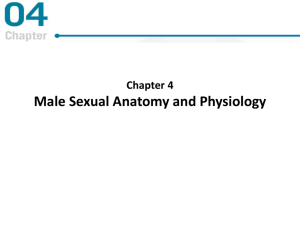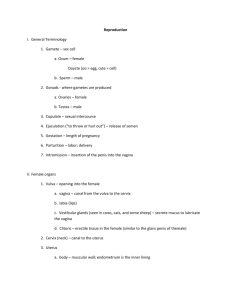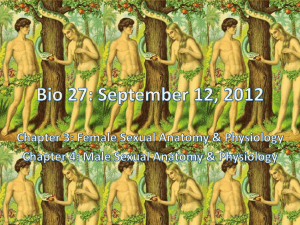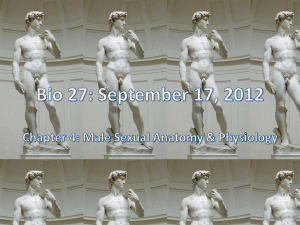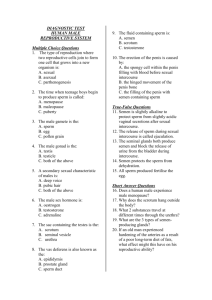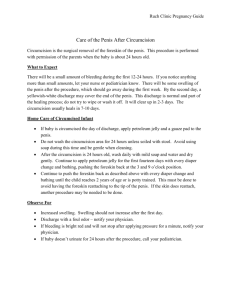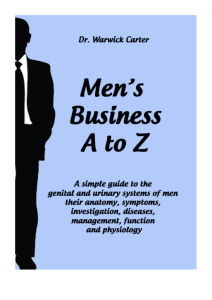The Female Reproductive System
advertisement
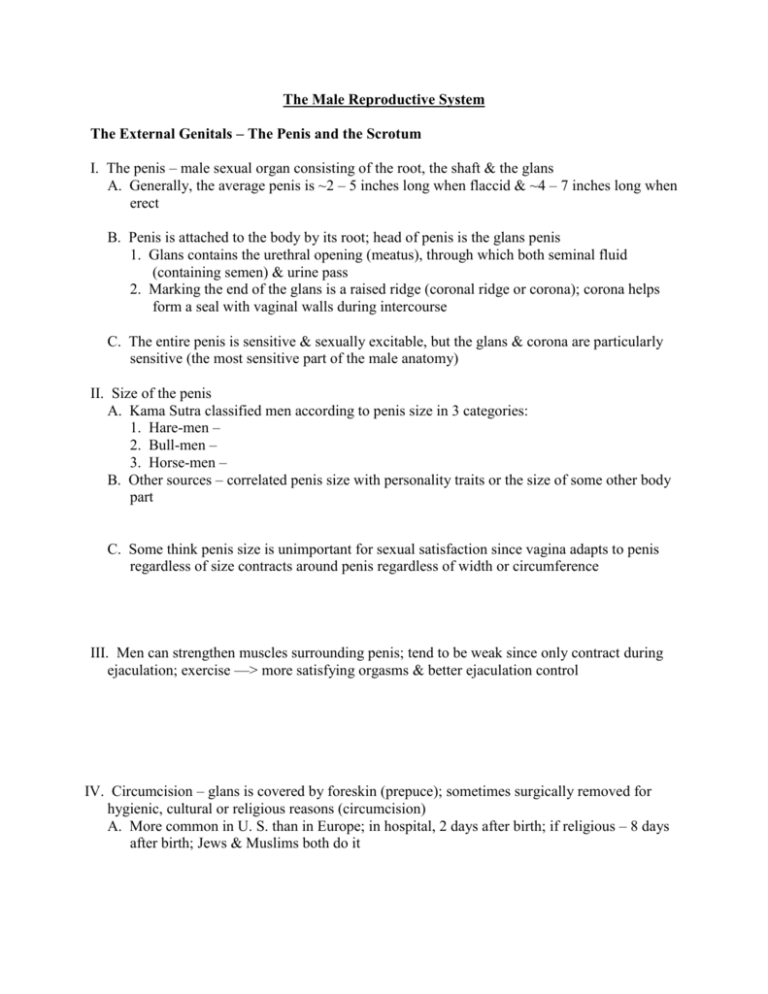
The Male Reproductive System The External Genitals – The Penis and the Scrotum I. The penis – male sexual organ consisting of the root, the shaft & the glans A. Generally, the average penis is ~2 – 5 inches long when flaccid & ~4 – 7 inches long when erect B. Penis is attached to the body by its root; head of penis is the glans penis 1. Glans contains the urethral opening (meatus), through which both seminal fluid (containing semen) & urine pass 2. Marking the end of the glans is a raised ridge (coronal ridge or corona); corona helps form a seal with vaginal walls during intercourse C. The entire penis is sensitive & sexually excitable, but the glans & corona are particularly sensitive (the most sensitive part of the male anatomy) II. Size of the penis A. Kama Sutra classified men according to penis size in 3 categories: 1. Hare-men – 2. Bull-men – 3. Horse-men – B. Other sources – correlated penis size with personality traits or the size of some other body part C. Some think penis size is unimportant for sexual satisfaction since vagina adapts to penis regardless of size contracts around penis regardless of width or circumference III. Men can strengthen muscles surrounding penis; tend to be weak since only contract during ejaculation; exercise —> more satisfying orgasms & better ejaculation control IV. Circumcision – glans is covered by foreskin (prepuce); sometimes surgically removed for hygienic, cultural or religious reasons (circumcision) A. More common in U. S. than in Europe; in hospital, 2 days after birth; if religious – 8 days after birth; Jews & Muslims both do it B. Arguments in favor of circumcision 1. Hygiene is a reason – several preputial glands (secrete hormones only after puberty) are found in foreskin under corona (Tyson's glands) 2. Others say that foreskin interferes with sexual stimulation since it is barrier to glans, but it retracts when penis is erect 3. Some cite higher penile cancer (rare), vaginal infection, cervical cancer, genital wart, other STD rates in partners of uncircumcised men – not certain either way 4. It should be removed if it is so tight that it hurts to have erection or there is pain during intercourse (phimosis) – much more painful & dangerous when adult C. Arguments against circumcision – Amer. Academy of Pediatrics released statements after 1971 that there was no medical reason to do it; in 1990 it revered its position V. The scrotum – located under the penis; a sac of skin containing testes & spermatic cords A. Comprises 2 layers 1. Outer layer – covered with hair & sweat glands 2. Inner layer (tunica dartos) – has muscle & connective tissue; regulates temperature in testes by drawing them up toward body if cold & hang away from body if warm B. Temperature of testes is always 5.6°F (3.1°C) cooler than internal body temperature C. Scrotum also contracts when inner thigh is stimulated or when it is chilled; due to contraction of cremasteric muscles in spermatic cord (cremasteric reflex) The Internal Genitals I. The urethra – a tube through the penis that begins at the bladder & ends at the meatus; provides a route for both semen & urine to exit the body A. Urine – waste product of the body stored in the bladder until expelled through urethra B. Semen – contains spermatozoa (sperm) & other substances II. Corpora cavernosa & corpus spongiosum A. Penis contains 3 spongy bodies: 2 corpora cavernosa & 1 corpus spongiosum; filled with networks of blood vessels & nerves B. During ejaculation, muscle surrounding corpus spongiosum (bulbocavernosus muscle) contracts & forces semen out through urethra III. The testes – suspended in scrotal sac by spermatic cords, vas deferens (through which sperm leave testes), blood vessels, nerves & muscle fibers A. Testes produce sperm (~50,000 per minute) & testosterone (a male sex hormone generally responsible for male secondary sexual characteristics) B. Within each testicle are ~1000 seminiferous tubules (produce sperm), a process called spermatogenesis 1. Cells between the seminiferous tubules are called interstitial cells & produce testosterone IV. Pathway of sperm A. Mature sperm - ~.0024 inches (.0060 cm) long, with a head, neck, midpiece & tail; normal one carries 23 chromosomes; one, sex chromosome, determines sex of baby 1. Stored up to 6 weeks in epididymis before moving up vas deferens to ampulla (enlarged portion of vas deferens) B. Ejaculatory process – begins with sufficient sexual stimulation & starts with fluids from glands 1. Fluid from prostate gland mixes with sperm & secretions of seminal vesicles to further aid sperm motility & prolong sperm life 2. Alkaline prostate secretions offsets vaginal acidity that would otherwise kill sperm C. Ejaculation – expulsion through penis of semen, the mixture in which sperm are carried; results from muscular contraction of glands & ducts of reproductive system 1. Expelling of semen is usually accompanied by orgasm (climax of a growing complex of pleasurable sensations 2. Both ampulla & seminal vesicles contract along with bulbocavernosus muscle surrounding corpus spongiosum Hormones I. Sometime during puberty, boys become capable of reproduction; accompanied by ability to ejaculate (initially ejaculate does not contain mature sperm) A. Increased reproductive capacity caused by increased androgen secretion followed by development of secondary sexual characteristics B. During puberty, increased testosterone leads to growth of penis, prostate, seminal vesicles & epididymis 1. Males cannot ejaculate before puberty because prostate & seminal vesicles are not functional until turned on by elevated testosterone II. Male climacteric – do males have something akin to menopause?; answer is unclear A. At about same age as women experience menopause some men experience midlife crisis 1. Men wonder about life's meaning thus far & worry about the future 2. They may become more people-oriented & less job/task oriented B. Hormonal evidence usually cited for male climacteric is decrease in testosterone production at ~40 – 50 1. However, many say drop is minimal & too insignificant to influence male behavior; middle-aged females have many of same concerns & fears & undergo self exam 2. Tough to separate the psychological & sociological from the identifiable physiological & hormonal changes C. Hormone therapy – testosterone supplements sometimes administered to treat erectile dysfunction in older men; testosterone levels often not low in all having such problems 1. Sometimes treatment is effective & sometimes it is not Self-Care and Prevention I. Males need proper hygiene & monitoring of reproductive health as well & should seek help when problems arise II. Breast cancer – happens but it is rare; 1600 new cases diagnosed in 1998; 400 men died in 1998; seen in men as early as 30s; though rare men should examine their breasts for lumps A. Breast exam in men is the same as for women III. The prostate A. Prostatitis – inflammation of prostate; symptoms are pain in lower back, pain when defecating, pain during a rectal exam, pus in urine B. Prostate cancer – estimated 184,500 new cases in 1998; estimated that 39,200 of them died of it; second leading cause of cancer death in U. S. (lung cancer is first) 1. Between 1989 & 1992, rates increased dramatically because of new PSA prostate-specific antigen) test detecting antigen made when prostate cancer is present 2. Factors that that place a man at risk for developing prostate cancer 3. Signs & symptoms C. Some of these symptoms may be caused by prostate enlargement, which is common as men age without presence of a tumor; called benign prostatic hyperplasia (BPH) 1. Treated with medication 2. Only way to distinguish BPH from prostate cancer is digital rectal examination (DRE) & PSA blood test D. Treatment if cancer is suspected consists of surgery, radiation and/or hormonal & chemotherapies if cancer is at a late stage 1. Significant potential for serious side effects of these treatments (erectile dysfunction and/or incontinence) 2. If cancer is low grade and/or at an early stage, there is often careful observation over period of time without immediate treatment E. Can do prostate self-exam but need a good understanding of anatomy IV. The testes A. Testicular cancer – most common form of cancer seen in men during late adolescence & early adulthood; most occur in men ages 15 to 40; ~7600 new cases in 1998 & 400 died 1. Risk is 4X greater for white men than African-American men; rate has doubled in white Americans over the last 40 years but stayed the same for blacks 2. Risk factors – not related to injury or vasectomy 3. Treatment – surgery (removal of testicle), radiation therapy and/or chemotherapy 4. Treatment is highly effective if cancer is diagnosed early 5. Self examination can lead to early detection – lumps, masses or thickened areas may be symptoms of abnormality (not always cancer) V. The penis – penile discharges of pus, painful urination, itching, sores or warts on genitals may indicate an STD A. Men should wash smegma away daily to prevent irritation or infection in themselves & partner
